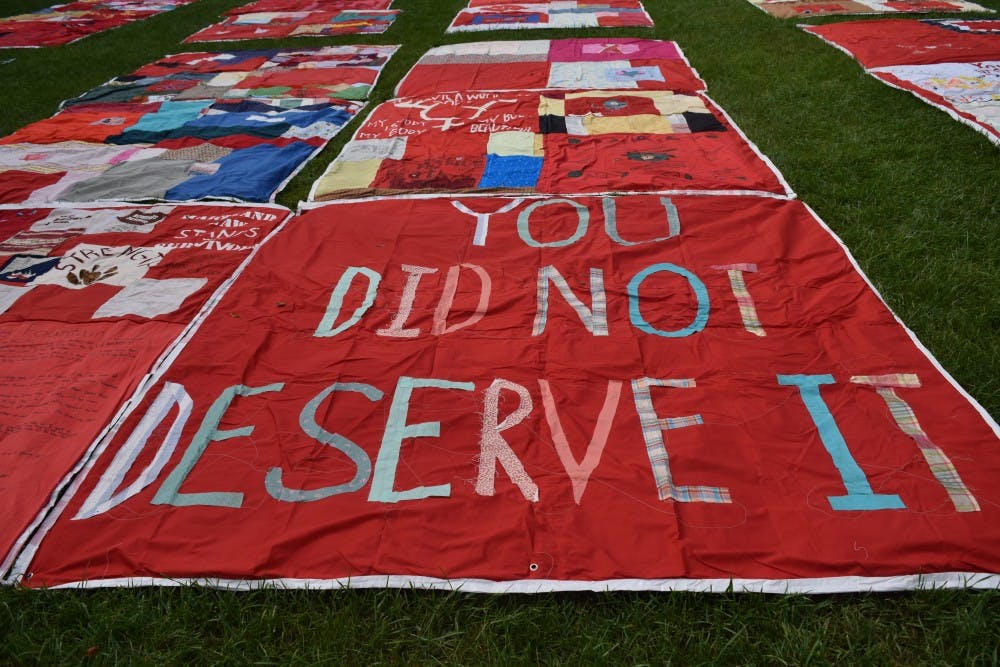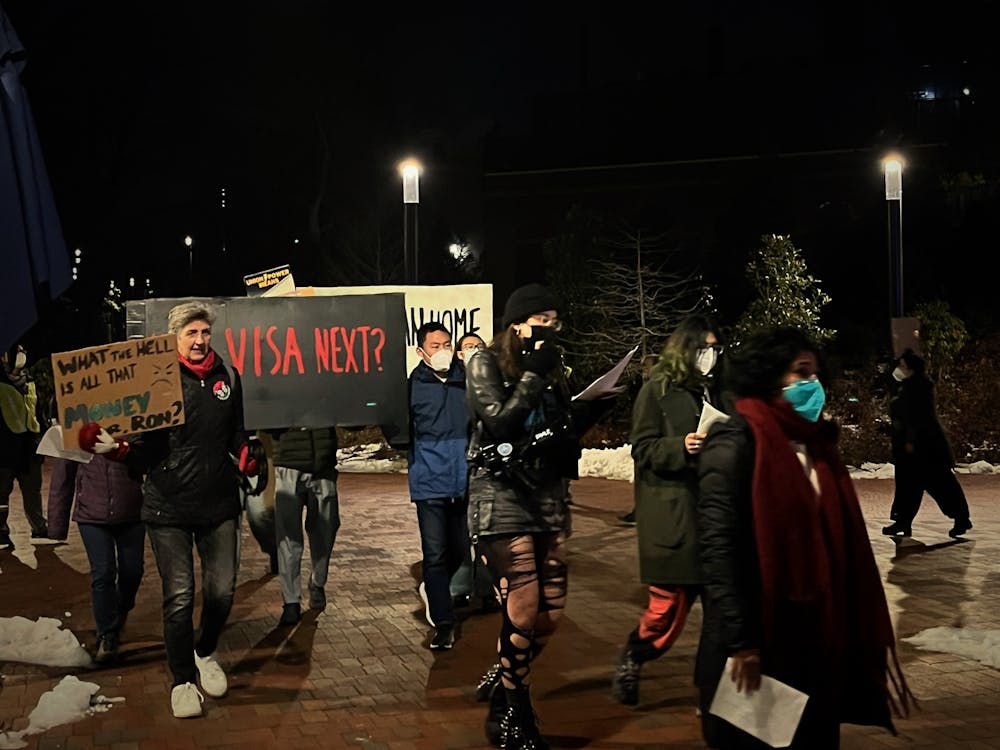The Baltimore-based art activist group, FORCE: Upsetting Rape Culture, brought the Monument Quilt to campus on Wednesday. The Quilt serves as a public display of solidarity with survivors of sexual violence and their allies.
Across the country, participants submit personalized red quilt squares highlighting their stories of sexual violence. The squares are then stitched together into the Monument Quilt, an ongoing collection of these experiences.
The Quilt has been displayed 46 times in 35 different cities and currently has almost 3,000 squares. FORCE plans to culminate this project next year on May 31, spelling out “Not Alone” in Quilt squares on the National Mall in Washington, D.C.
Shalini Vijayekumar, vice president of Hopkins Feminists, appreciated what the Quilt stood for in today’s political climate.
“Seeing the Quilt on campus is empowering and necessary, especially with the current political crisis surrounding Brett Kavanaugh and his sexual assault allegations,“ she said. “Each person’s story, combined into this one amazing Quilt, is a symbol of unity and strength in the face of opposition.”
The Monument Quilt was created in 2010 by activists Hannah Brancato and Rebecca Nagle. They were struck by the realization that there were few platforms to honor survivors of sexual and domestic violence.
“The Monument does not glorify the horrors. It is a place for grieving and loss,” Brancato said. “We felt that there needed to be a public space to recognize public space to recognize the trauma that survivors go through. It is not their burden alone to carry.”
Brancato, a professor at the Maryland Institute College of Art (MICA), explained that quilts are usually associated with tradition. The skill to sew a quilt, along with the quilt itself, she said, is passed down through the generations. For Brancato, the Monument Quilt reclaims that tradition.
“We are creating a new tradition of telling and witnessing these stories instead of keeping them a secret and behind closed doors,” she said.
She emphasized that survivors’ stories are not one-dimensional, which is why the Quilt partners with a variety of organizations to lead directed campaigns in order to reach populations of different abilities and classes.
“Everybody’s identity as a survivor affects the way that they are treated and access they have to resources and how they are treated before, during and after,” Brancato said. “The intersectionality of sexual violence is important in the MQ, and that is because survivors are telling their own stories on their own terms.”
Squares on the Quilt, she explained, address issues like the criminalization of black women and girls who defend themselves and the barriers survivors on Native American reservations face when they attempt to bring charges against non-native people.
Quilt Studio Director Shanti Flagg explained that the Monument Quilt has had a long-standing relationship with Hopkins, dating back to fall 2016. She added that the University has remained supportive and respectful of the work that has gone into constructing the Quilt, particularly considering that many of the volunteers are Hopkins students.
“[The Quilt] has become an organizing point for a lot of people around the country,” Flagg said. “It’s more than just a project — it’s become about all the collaboration that has gone into it.”
The widespread impact of the Quilt, to Flagg, has exceeded what the founders could have initially predicted.
“A lot of people, if they aren’t artists or don’t consider themselves artists, won’t do it alone,” Flagg said. “A lot of people have never shared their story, and so they do it through art work.”
E Cadoux, the artist in residence and youth coordinator at FORCE, appreciates that conversations about sexual violence are becoming increasingly prevalent in mainstream media. However, Cadoux thinks it is important that physical projects like the Monument Quilt remain relevant as well.
“A lot of the discourse surrounding assault and healing right now is happening online, which is wonderful and pivotal but simultaneously can feel isolating,“ Cadoux said. “We want to make sure that we are providing non-virtual community as well.”
Center of Health Education and Wellness (CHEW) Sexual Violence Prevention and Education Coordinator Alyse Campbell explained that the Quilt was initially displayed at Hopkins because CHEW wanted a prominent and visible way to show its support for survivors both on campus and within the Baltimore community.
According to Campbell, there has been an expansion and revamping in University policy regarding sexual assault and gender violence in recent years.
However, Campbell added that these resources on campus are often underutilized. She explained that most of the work that CHEW does is broad and seeks to reach a wider audience, but she plans to work with smaller groups in the future, especially those that have been historically marginalized.
Campbell commended the Monument Quilt for giving survivors, both those who are comfortable with sharing their story and those that are not, a safe healing space.
“How can we, as a community or as individuals, support and empower the people who are not able to come forward, who might still be not comfortable seeking resources, even when they’re not ready, even when they’re never ready?” she said.
For junior Isadora Schaller, who worked as an intern with the Monument Quilt, the experience was eye opening.
“The work that FORCE and Monument Quilt have done to normalize this discussion is so important, because sexual assault is such a divisive topic,” Schaller said.
She explained that the current political climate, especially in D.C., discourages survivors of sexual violence from coming forward and sharing their experiences.
“We have such a tiny portion of our population that steps forward and reports, but our immediate impulse is to drag them through the dirt and tell them that they’re lying,” Schaller said. “It’s so terrible for survivors to see what’s happening right now in Washington and to see this national outcry against them.”
Schaller appreciated the work that CHEW does with survivors but added that the University could do more to improve the way it handles sexual assault investigations.
“Universities are really incentivized to not look into reports because it’s bad for donations,” Schaller said. “It’s bad for publicities and press. It’s bad for universities to have issues of rape.”
Mayuri Viswanathan, co-director of the Sexual Assault Resource Unit (SARU), believes that the multiplicity of voices included in the Quilt speaks to the pervasive nature of sexual violence.
“You can see what an endemic issue sexual violence is and how survivors not only on this campus, but in a lot of different communities, need resources,” she said.
According to Viswanathan, the Quilt’s transformative power goes beyond increasing awareness of sexual violence and helping survivors and allies voice their stories. She felt that the Quilt transforms spaces where it is displayed.
“It’s like a different space altogether; it doesn’t feel like we are on campus anymore when we are walking around and looking at the Quilt,“ she said.
Woudese Befikadu, a senior who interned at FORCE over the summer, volunteered at the Quilt to collect and document the squares. Befikadu remembered being struck by the Quilt’s enormity when she saw it for the first time.
“I remember seeing it freshman year and thinking that it was so powerful. It has a shock value that brings it attention, but it is beautiful at the same time,” Befikadu said.
Junior Emily Burnette has volunteered with the Monument Quilt since her freshman spring. Burnette currently volunteers as the Monument Quilt weekly coordinator through Alpha Phi Omega, a service fraternity on campus.
The Monument Quilt, according to Burnette, demonstrates the powerful impact of providing a healing space to survivors of sexual assault and domestic violence.
To Burnette, the Quilt is much more than an art project.
“It’s a movement — it’s a show of support, which is something a lot of survivors don’t have,” Burnette said. “So knowing that there are so many people across the world and U.S. who do believe them, who do hear their stories and support them, is really important. That kind of thing can’t really be ignored.”
If you or someone you know has experienced sexual violence, you can seek help from the following Hopkins-specific, local or national confidential resources: JHU Sexual Assault Resource Unit (SARU) 24/7 Peer Crisis Support Hotline — (410) 516-7887; JHU 24/7 Sexual Assault Helpline — (410) 516-7333; TurnAround, Inc. 24/7 Helpline — (443) 279-0379; Rape, Abuse & Incest National Network (RAINN) 24/7 Sexual Assault Hotline — 1 (800) 656-4673.





